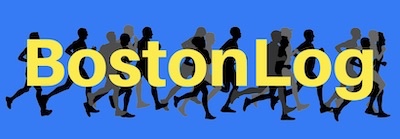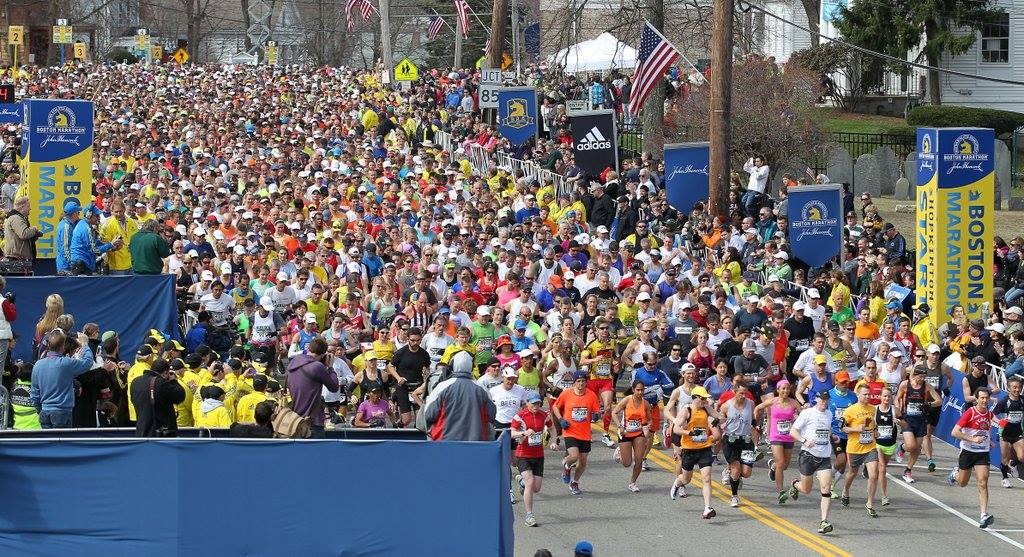This Brief History of the Boston Marathon is taken from Joe Muldowney’s book Running Shorts, a “Collection of Stories and Advice for Anyone Who Has Ever Laced Up a Pair of Running Shoes,” as seen through the eyes of a veteran runner.
A competitive runner since 1976, Joe Muldowney has run the Boston Marathon 16 times. His 50+ marathons include a dozen completed under 2:30, and he owns a personal best time of 2:22:54. At age 57, he turned in a marathon time of 2:58:54.
Our thanks to Joe for sharing this concise yet personal history with BostonLog readers.
A Boston Marathon Primer
The young woman behind the desk in the cramped lobby of the Fenway Motel looked concerned. Before her stood a gaunt figure with sunken eyes, reeking of stale sweat, and caked with salt. A shiny space blanket, issued to him at the finish line, hung from his shoulders like a super hero’s cape, crinkling with each movement. A unicorn medal hung from his neck, its “82nd” signifying the long tradition of the annual Patriots Day race, his badge of honor earned by virtue of completing his first Boston Marathon.
The long walk from the finish line at the Prudential Center to the Fens had been more like a painful shuffle, robbing him of his last few ounces of stamina. He needed the key to his room, where a bed and a warm shower awaited.
Suddenly, like a bolt of lightening, the plier-like vise grip bit into his weakened right hamstring. A cramp, the kind that strikes without warning in the middle of the night, seized him. A painful, silent grimace crossed his face.
At that moment, as if reaching out to the helpless soul who stood before her, the desk clerk asked, “May I help you?” White-hot pain consumed him. He gripped the marble desk top. Before he could summon enough strength to reply, a middle-aged man, who just couldn’t grasp the mentality of those who ran 26.2 miles for fun, joined the attendant behind the desk. He glanced at the pained figure before him, and in his Boston accent drawled, “Not unless yaw name is Gawd!”
Despite a debilitating leg cramp and a wiseguy at the hotel desk, on the third Monday of April in 1978, my love affair with the Boston Marathon began.
Perhaps my fondness of history draws me to a place that declares a holiday celebrating the day seventy farmers stood up to seven-hundred British Regulars on the Lexington Green, shed blood at the North Bridge in Concord, then chased the redcoats back to Boston, igniting a war that would separate America from Great Britain and launch us on the path to freedom.
Maybe it’s the charm of Betty, the receptionist, at the hotel in Braintree, who, on the Saturday before the 2010 Boston Marathon, instructed me where to “paak my caa.”
It could be the Irish punk sounds of Boston’s Dropkick Murphys, the blue, green and orange lines of the MBTA (Massachusetts Bay Transportation Authority), the sight of Fenway Park’s Citgo sign beckoning as the race winds down, the screaming girls at Wellesley College, or the army of boisterous spectators that swells in every town along the way, then increases and erupts as you enter the city. The crowd that, more than any other marathon crowd in any other city, displays a genuine respect for every runner, and treats each competitor like an Olympic champion.
Whether it’s a single reason, or combination of many, the Boston Marathon, in my opinion, is the greatest footrace on the planet.
Here’s why:
Hopkinton, the starting line, became a town in 1715. Ashland, at the three-mile mark, was settled in 1750. Framingham, at mile six was settled in 1650, Natick in 1651, Wellesley, at the half way point, in 1660, and Newton, where the famed hills begin, in 1630. Each step of the Boston Marathon takes the runners through some of the oldest communities in the country.
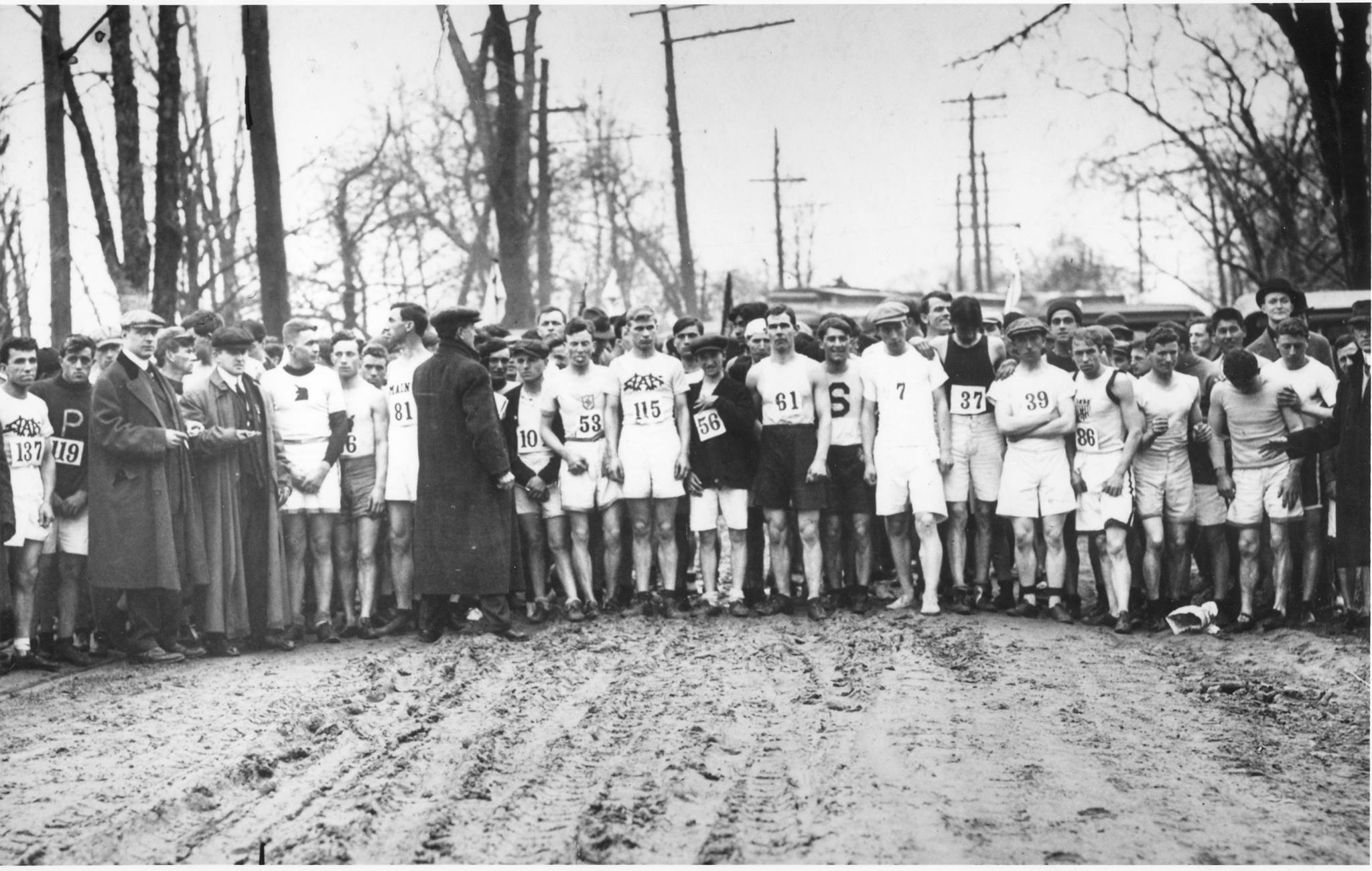
Then there’s the rich history of the race itself.
On Patriots’ Day, April 19, 1897, a handful of runners covered the 24.5 mile distance from Metcalf’s Mill in Ashland to the Irvington Oval in Boston. John J. McDermott was the winner of that first Boston Marathon. His time of two hours, 55 minutes, 10 seconds, was nearly seven minutes ahead of his closest competitor. In all, fifteen men competed in the first Boston race.
In 1908, the official length of the Olympic marathon was set at 26.2 miles, the distance from Windsor Castle to the Olympic Stadium in London; and in 1914, the Boston Marathon conformed with the Olympic standard, moving the starting line to Hopkinton. Clarence DeMar earned his third consecutive Boston Marathon victory that year, smashing the world record by blistering the new course in a time of 2:29:40. DeMar went on to win a record seven Boston Marathons, and earned a bronze medal in the marathon at the 1924 Paris Olympic Games. DeMar deservedly earned the moniker “Mr. DeMarathon.
DeMar may hold the Boston Marathon record with seven victories, but it was John A. Kelley from West Medford, Massachusetts, who finished second a record seven times, whose name became synonymous with the venerable race, who earned the adulation of runners around the world and was named by Runner’s World magazine as the Runner of the Country.
Johnny Kelley notched his first of two Boston Marathon victories in 1935, after having endured a second place finish the year before. Kelley became the favorite to win the 1936 race. He did not, but the story of his defeat is richly steeped in Boston Marathon folklore.
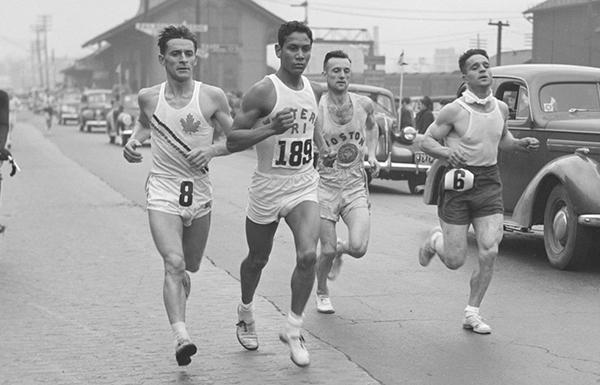
Climbing the last of the Newton Hills and lagging behind the leader, Elison “Tarzan” Brown (a Narragansett Indian whose shoes fell apart at the 21 mile mark of the previous year’s race), Kelley surged up the incline, passing the struggling frontrunner. At that point, Kelley, by all accounts a sportsman, patted Brown on the back as a sign of respect. Brown, however, construed the gesture as a taunt, and became infuriated. The Indian then sprinted down the other side of the hill, into the city, breaking both Kelley’s will and his heart.
The site of running’s most famous pat on the back is forever known as “Heartbreak Hill.”
Kelley went on to win the 1945 Boston Marathon, and he placed in the top five a remarkable fifteen times between 1934 and 1950. He also ran in two Olympic Games, at Berlin in 1936, where he finished 18th, and at London in 1948, when at age forty he placed 21st
In 1992, at the age of eighty-four, he ran his last full Boston Marathon. That race represented his 61st start at Boston, with fifty-eight finishes. He ran the last seven miles of the race for the next two years.
In 1993, a statue of the distance running icon was erected on the Boston Marathon course in Newton, about a mile before the base of Heartbreak Hill. Kelley, who died in 2004, at the age of ninety-seven, still presides over the race participants as they pass through the town of Newton.
Runners from Korea and Japan posted five Boston Marathon wins in the decade following World War II. In 1953, Japan’s Keizo Yamada shattered the world record mark, taking the Boston time into the teens by clocking a 2:18:51.
Finns took over the mantle of victory at Boston, winning the race in 1954, 1956, 1959, 1960, 1961, and 1962.
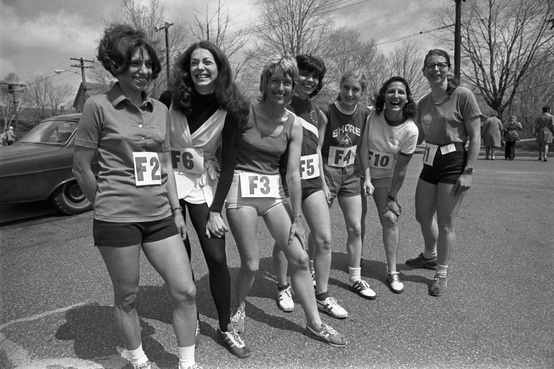
Roberta Gibb is recognized as the first female Boston Marathon finisher. In 1966, she sent in her race entry form, but was refused because she was a woman. She ran unofficially anyway, and finished the race in a time of 3:21:40. She ran unofficially again in 1967, finishing an hour ahead of Katherine Switzer. Switzer attempted to enter the race officially, using her initials only: “K.V. Switzer.” Race official Jock Semple, incensed by what he viewed as blatant deception, sprang out of the crowd and attempted to physically remove her from the race, shouting, “Get the hell out of my race and give me those numbers.” Switzer’s boyfriend shoved Semple, sending him careening back into the crowd from which he had emerged. The photograph of the sexist incident made national headlines.
Women were finally officially allowed to run the Boston Marathon in 1972. Nina Kuscsik bested seven other women to win that race in a time of 3:10:26.
In 1970, the Boston Marathon took a bold step by introducing qualifying standards to the event. Participants were now required to submit a legitimate qualifying time in order to enter the race. Being the first race of its kind to actually turn people away, the move piqued interest in the Boston Marathon. Suddenly, everyone was attempting “to qualify.”
While Frank Shorter’s Olympic marathon victory in 1972 may have ignited the Running Boom, it was Bill Rodgers’ Boston Marathon triumph in 1975 that fueled the fire.
The easy-going, blonde-haired Rodgers had turned in a modest time of 2:19:34, placing 14th the previous year, but training up to one-hundred-thirty miles a week, often on the Newton Hills had prepared him for a breakthrough race.
In 1975, Rodgers stunned the world at the Boston Marathon, obliterating the course record, with a time of 2:09:55. What’s the most remarkable about this time is along the way he stopped four times at water stations and once to tie his shoe.
The Boston field topped two-thousand competitors that year. West German Liane Winters set the women’s world record, with a time of 2:42:24, and the Wheelchair Division of the race began, with Bob Hall covering the course in 2:58:00.
Bill Rodgers went on to win the Boston Marathon in 1978, 1979, and 1980. In 1979 he lowered his course record to a 2:09:27. Four decades after his first Boston, well into his sixties and a prostate cancer survivor, Boston Billy was still regularly training and competing. Rodgers, who also won four New York City Marathons, continues to serve as an ambassador for the sport of long distance running. He has never lost his humility, and remains one of the true “good guys” in the entire sports world. Bill Rodgers, one of the greatest marathoners of all times, sums up his life best with a quote from which we can all benefit: “To be a consistent winner means not just preparing for one day, one month, or even a year, but for a lifetime.”
The third Monday in April can bring a great variety of weather conditions to the eastern United States. More often than not, the temperatures in Boston on that day are cool, raw, and damp, but in 1976, record heat descended upon the east coast. For the over 1,900 runners at the Boston Marathon that day, the ninety-eight degree thermometer reading at the starting line led to a 40% attrition rate. Jake Fultz was one of the survivors, crossing the finish line in a sunbaked time of 2:20:19.
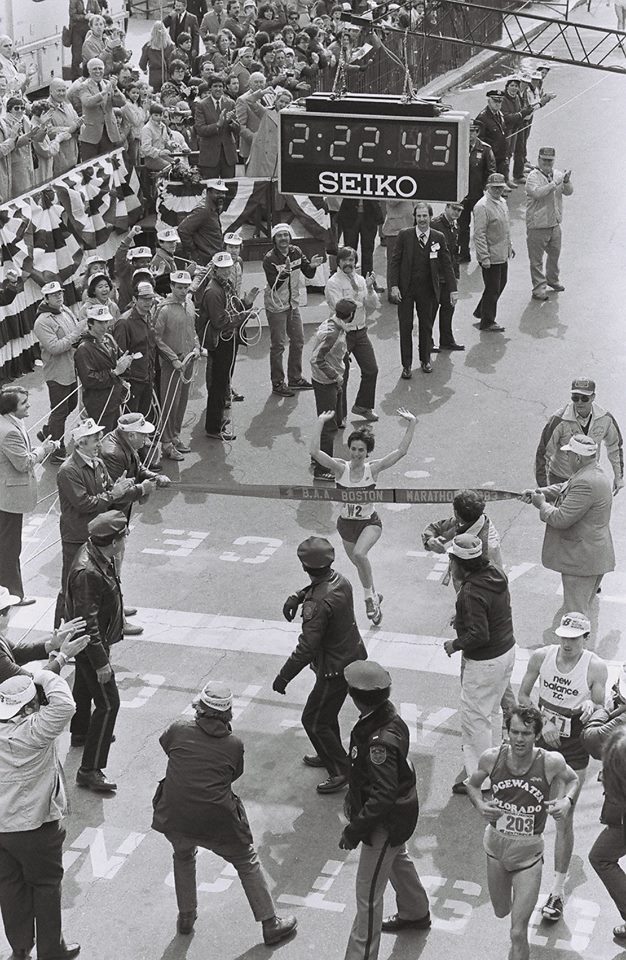
By 1979 the Running Boom was in full swing, attracting a record crowd of 7,879 runners to Boston. More than 3,000 runners broke the three-hour barrier in that race. That’s right, over three-thousand! Better still, fifty-one broke 2:20, in what, statistically, may have been the marathon with the greatest depth of times in the history of the sport.
A young Joan Benoit, a student at Bowdoin College, set an American women’s marathon record, with a 2:35:15 performance at the 1979 event.
Baseball had its steroid scandal; long distance running had Rosie Ruiz.
It is painful for me to write about this. First, the 1980 Boston Marathon was the only marathon in my career that I failed to complete. A nagging back injury caused me to drop at the sixteen mile mark of the race. From there I hobbled to the Massachusetts Turnpike, where I hitched a ride back into the city.
Well, as it turned out, the apparent race winner, a somewhat out of shape, toneless, amazingly fresh looking woman by the name of Rosie Ruiz, never completed the race either.
In an age prior to chip timing or camera monitoring, this fraud apparently emerged from the crowd on Commonwealth Avenue, about a half mile from the finish line. She reveled in the adulation of the thousands of spectators, most of whom, naturally believed she had conquered the challenging course, and was now on her way to victory. Ruiz completed the deception with waves to the crowd, and even accepted the ceremonial laurel wreath presented to the race winners.
She was disqualified from the race later in the week, when a body of evidence indicated she had deceived just about everyone, robbing the spotlight from the true victor.
The real winner of the race, a petite gracious Canadian, Jacqueline Gareau, was eventually declared the winner. Her time of 2:34:28 was a new course record. Race officials ceremoniously allowed her to cross the line a week later.
Thanks to the despicable actions of Rosie Ruiz, intensive video surveillance and computer monitoring were instituted at Boston and all major road races.
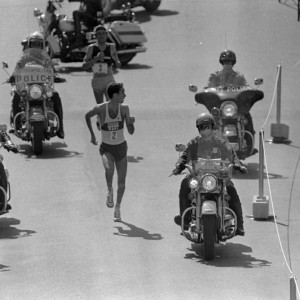
The 1982 Boston Marathon will forever be remembered as “The Duel in the Sun.”
Officials in the Boston Athletic Association stubbornly refused to budge on the traditional noon starting time of the race, and the conditions at the starting line were arid. The sky was cloudless, and the sun became a red-hot orb by early morning, punishing runners not yet acclimatized to the heat after a brutal northeastern winter.
I was pleased with my time of 2:28:43 at the race, but my most significant pain in the twenty-four or so hours after my finish resulted from the bright pink lines of sunburn which outlined the perimeter of my race singlet as well as on my ankles above the sock line.
For sixteen miles it was a three-man race. Four time race winner Bill Rodgers battled with the young, brash, two-time New York City Marathon champion, Alberto Salazar, and a soft-spoken Midwesterner, Minnesota’s Dick Beardsley.
The pace was as hot as the day itself, as the dry temperatures climbed into the high 70s
The first victim among the leaders was Rodgers, who fell off the pace at sixteen miles. It was now a two-man race. Salazar, clearly the favorite, attempted to break his rival on the Newton Hills, but Beardsey hung tough, unfazed. The crowds were frenetic as the duel continued down the long stretch of Commonwealth Avenue. Beardsley had a slight edge when, near the Eliot Lounge and less than a mile to go to the finish, his hamstring locked. Salazar, the best marathoner in the world at that time, seized the moment and captured the lead. But the race was far from over. Within a hundred yards of the onset of his hamstring cramp, Beardsley encountered a major source of irritation to most drivers: a pothole. Like most drivers, he hit it …with his bad leg! Miraculously, the jolt somehow loosened the hamstring and the battle was on again. Beardsley drew even with Salazar.
The final stretch of race real estate on Boylston Street became crazed by the deafening cheers of the crowd, as the two champions sprinted to the finish line, flanked by motorcycle police, with Salazar emerging the victor. Both men had smashed the course record. Salazar clocked a time of 2:08:52 and Beardsley followed a mere two seconds back at 2:08:54. It was the first time two men had broken 2:09 in the same race.
Salazar, however, paid a steep price for his victory. Severely dehydrated, his body temperature dropped to a near fatal eighty-eight degrees, and it took several liters intravenous fluids to stabilize him. By Salazar’s own admission he was never the same after that race.
In 1983, the Boston Marathon reached its peak in attracting an incredible depth of running talent. Marathons were springing up everywhere, and most were offering prize money. Boston held steady in remaining an ‘amateur’ race, but the times were changing.
For me, the 1983 race was unforgettable. I achieved my personal best marathon time of 2:22:54, a mark that would win many marathons today. At Boston in 1983, however, it earned me 125th place.
As I made the turn onto Boyleston Street, icy chills shot down my spine as I realized I would achieve my personal best, and possibly break the 2:23 barrier. What’s more, the crowd was as excited as I. I’ve always loved the enthusiasm of the Boston Marathon spectators, but could it be they were cheering wildly for me, recognizing I was about to complete my personal best marathon performance
Nah!
It seems someone had stolen my thunder.
For the entire race, a female had been ahead of me. It was inconceivable to me that, at that time, a woman could turn in a time of less than two hours 23 minutes, but I was wrong.
Joan Benoit, who ran the first half of the race at a 2:17 pace, shattered the world record by more than two minutes, running a time of 2:22:43. It was she, not I, for whom the crowd cheered.
Greg Meyer captured the men’s race. He is the last American to win the Boston Marathon for over 30 years.
The 1985 race marked the end of the “old” Boston Marathon. Still devoid of prize money, top marathoners went elsewhere, and the race was won by England’s Geoff Smith in a time of 2:14:05. It would mark the last time the race would finish at the Prudential Center, as John Hancock Financial Services would take over as the chief race sponsor. The next year prize money was offered, and Australia’s Rob deCastella cashed in big-time. He crushed the course record with a time of 2:07:51. Norway’s Ingrid Kristiansen took home the women’s prize with a time of 2:24:55.
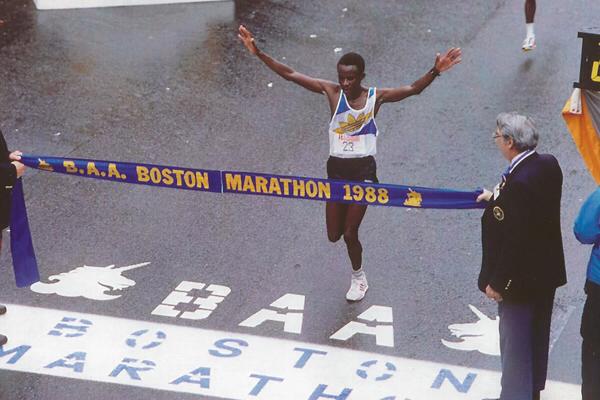
In 1988 the African Revolution began at Boston. That year marked the closest finish in race history, as Kenya’s Ibrahim Hussein and Tanzania’s Juma Ikangaa battled for 26 miles, and 285 yards, with Hussein outsprinting his rival in the final one-hundred-meters, to win in a time of 2:08:43, a one second margin of victory.
By 1990, the field of competitors at the Boston Marathon had swelled to 9,362. Italy’s Gelindo Bordin broke Boston’s Olympic jinx by becoming the first men’s Olympic marathon winner to also capture a victory at Boston. His time was 2:08:09.
1994 was a record-setting year at Boston. Kenya’s Cosmos Ndeti broke Rob deCastella’s course record, by turning in a time of 2:07:15. Germany’s Uta Pippig shattered Olympic champion Joan Benoit-Samuelson’s course record by nearly a minute, with a time of 2:21:54.
The Centennial edition of the Boston Marathon was held on April 15, 1996. Several days before the race, a spring snowstorm had dumped more than a foot of snow on the Boston area. Race officials, in preparation for the largest field ever to run the race, used helicopters to dry off the staging area in and around the starting line at Hopkinton.
Officially, 38,708 competitors entered the race legally. Estimates, including unofficial runners, ran as high as over 40,000. Remarkably, 35,868 runners finished the race. The first to cross the line were Moses Tanui and Uta Pippig, but the real winners were the near 36,000 runners who earned the indelible stamp of crossing the finish line on the 100th anniversary of the historic race
At the first Boston Marathon of the new century, three runners made the final turn onto Boyleston Street together. The finish turned out to be the closest in Boston Marathon history. Elijah Lagat outsprinted former Boston Marathon champion and fellow Kenyan countryman, Moses Tanui, as well as Ethiopian Gezahenge Abera. Lagat and Abera were awarded the exact same times of 2:09:47, in what amounted to a photo finish; while Tanui posted a 2:09:50.
The women’s race mirrored the men, with Catherine Ndereba crossing the finish line in 2:26:11, followed by Irina Bogacheva, and Fatuma Roba, who both registered times of 2:26:27, the closest women’s finish in race history.
Kenyan Margaret Okayo smashed the women’s course record in 2002, with an incredible time of 2:20:53, with Robert Kiprono Cheruiyot lowering the men’s record in 2010, running a 2:05:52
The following year, the Boston Marathon record reached a new level of excellence. Under perfect weather conditions at the 2011 Boston Marathon, Kenya’s Geoffrey Mutai astounded the world marathon community by running the fastest marathon time in history. His 2:03:02 stands as a remarkable running accomplishment, representing a pace of around 4:45 per mile.
Ryan Hall obliterated the American record in the same race. His time of 2:04:58 earned him 4th place.
Between 1988 and 2012, Kenyan runners captured 20 of 24 Boston Marathon titles. These incredible athletes train hard, lead remarkably Spartan lives, eat little red meat, train at high altitudes, and have a burning desire to succeed at earning a living doing something they love (while their average countrymen earns about $7,000 a year).
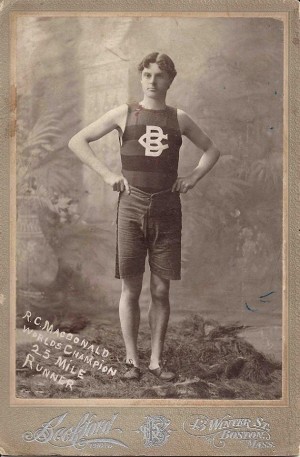
The Boston Marathon became international when a Canadian won the second race in 1898. North Americans took all but one Boston race before 1946, but after World War II, Boston quickly became global, long before anyone coined the term “globalization.” Boston winners have hailed from Europe, Asia, Africa, and Australia, as well as North and South America. Baseball may have its World Series, and soccer the World Cup, but Boston is, indeed, the World’s Marathon.
My Boston Marathons have ranked among some of the favorite and best races of my life as a runner. Except for the 1980 failure, I have never had a bad race at Boston.
The hospitality of the New Englanders who love their marathon like they love their Red Sox, has been incredible.
A corporate executive once opened up his home to a group of us in 1979. He threw in tickets for a Sox game. I sat along the first base line, seemingly able to reach out and touch the first base bag.
I’ve run along the rocky Maine coast, on Old Orchard Beach, during a stay on Marathon weekend.
Randy Haas and I, thanks to our sponsor, the now defunct Eastern Airlines, once spent race weekend at the posh Copley Plaza Hotel near the finish line of the race.
The Munier family of Newburyport graciously provided lodging for me on several occasions. In addition to getting me to and from the race on time, the patriarch of the family, Bob, served up post race homemade waffles, cooked on a century old, square waffle iron, the day after the race.
From waiters and waitresses, from race volunteers to Boston’s Finest, folks in Beantown have always made this race special for me and the thousands of runners and their families who descend upon the city on race weekend.
In 1987, Haas and I had both turned in decent race performances. After the race we went to the Boston Beer Works, a tavern near Fenway Park. There we were greeted as conquering heroes. To Bostonians, finishing the Boston Marathon is the equivalent of reaching the Major Leagues. Running a time of sub 2:30 is like playing in the World Series.
Heck, runners ride the subway for free on race day.
It’s Marathon Monday, but in Maine and Massachusetts, it’s Patriots Day, so not only do people have the day off from work and school, many of them are stationed somewhere along the race course.
If you’re a runner, then, the Boston Marathon is sensational, in that it stimulates one’s senses.
At Hopkinton a sign reads, ‘It All Begins Here.’
As you emerge from the busses that transport the runners to the starting line, the air is pungent with the odor of muscle gels and job johnnies. The loudspeaker blares with music and incessant announcements
At the starting line runners are tightly cramped and no matter what the temperature, body odor is rampant. That rivulet that just enveloped your feet is may be urine from the runners behind you who need to relieve themselves one final time. Depending where you are in the crowd, you may or may not here the starting gun, rather, you follow the crowd and slowly shuffle until you reach the blue and yellow emblem at the starting line.
Your adrenaline courses through your body as you weave through the congestion of the first couple of miles. The greatest elevation drop on the entire course occurs in the first mile, where you plummet 130 feet. You stride effortlessly on the downhill, and then you nearly stop and you encounter runner roadblocks in front of you. Local folks line the narrow road, some extending their hand in anticipation of a slap from a runner. Fraternity houses blast music while their inhabitants toast your efforts. Springsteen’s “Born to Run” and the Chariots of Fire theme songs are still popular tunes. Crowds swell near the Ashland clock tower around the four-mile mark and again at the Framingham Train Depot at mile six. From there you settle in as the hills roll, until you enter the town of Natick at mile ten.
Crowds become sporadic in a prelude to one of the most electric portions of the race
It starts as a high-pitched buzz, followed by a town sign, then bedlam that quickens the pace of all runners. At the exact half way point in the race, the girls from Wellesley College line both sides of the race course. If you’ve ever watched the grainy, black and white videos of the early Beatles’ concerts, you have an idea of the shrill, frenzied cheers that emanate from the enthusiastic coeds. Male runners go crazy. Many a Wellesley girl has received a sweat soaked kiss from a middle-aged male runner. The volume and pitch seem to rise when a female runner passes. Wellesley serves as a farewell to the predominately downhill, relatively easy course completed, and the monster challenge yet to come.
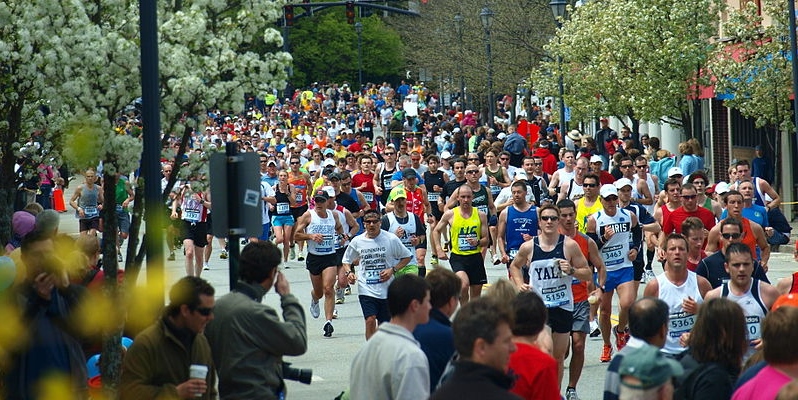
The Newton Hills begin around mile sixteen. If you hail from my part of the world these inclines are far from intimidating, but their placement in the race is. Thighs that have suffered damage from many downhill portions of the course fatigue easily on the Newton Hills. After the first three hills, the fourth, and final, infamous Heartbreak Hill, does, indeed become a challenge. It rises 88 feet over half a mile stretch, and it appears between miles twenty and twenty one. Enthusiastic crowds, twenty to thirty spectators deep, line both sides of Heartbreak Hill, screaming words of encouragement to fatigued runners.
Once you’ve conquered the Newton Hills, though, the best is yet to come.
Past Boston College a long downhill takes runners onto a flat stretch of road, where the city crowds continue to grow. In the distance, Fenway Park’s Citgo sign looms, as does the crowd, infused by the Red Sox fans exiting the ball game that began at 11:00 a.m. Two kilometers along the long stretch of Commonwealth Avenue, and the finish line nears. Spectators cheer your name, as they have all along the route. Many Boston Marathon spectators have newspaper in hand, eager to match a number with your name.
Abruptly, you make a right on Hereford Street. It is almost deserted, little more than an alley.
Near the finish of the world’s most famous marathon, there is a momentary letdown as nearly twenty-five and a half miles of screaming spectators have dwindled down to a handful. Hereford Street is the tunnel that leads you into the stadium.
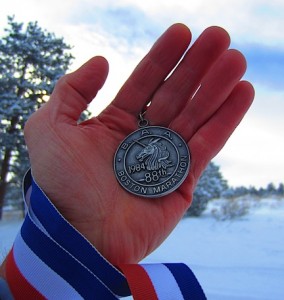 A left onto Boylston Street and all the training miles become worth it. The dank winter days when the icy wind sliced your face and the darkness seemed to envelope you out of nowhere. The twenty-mile runs, where you dragged yourself out of bed in the freezing temperatures, and you hobbled around for the rest of the day as if you were preparing for your 100th birthday party.
A left onto Boylston Street and all the training miles become worth it. The dank winter days when the icy wind sliced your face and the darkness seemed to envelope you out of nowhere. The twenty-mile runs, where you dragged yourself out of bed in the freezing temperatures, and you hobbled around for the rest of the day as if you were preparing for your 100th birthday party.
The two jello-pops you call your legs spring back to life as you feel as though you’ve come out of a tunnel at the Rose Bowl or you’ve just hit the home run to win the World Series. You are punched by the roar of more than 50,000 people who line the wide thoroughfare, their thundering cheers punctuated by the clanging sound of cowbells and, to them, you are the Olympic champion. Goose bumps emerge all over your sweat drenched body. Blow kisses to the adoring crowds, give them a bicep flex, or a cup your hand to your ear, like I have, and the cheers become deafening. You hit the 26-mile mark and you look for your family. In the crowd, through tears of joy, you can usually pick them out. You cross the finish line spent. Often elated, sometimes disappointed. The medal is placed around your neck.
You have followed a trail of 12 decades of Boston Marathon champions.
Now, YOU are a Boston Marathon champion.
